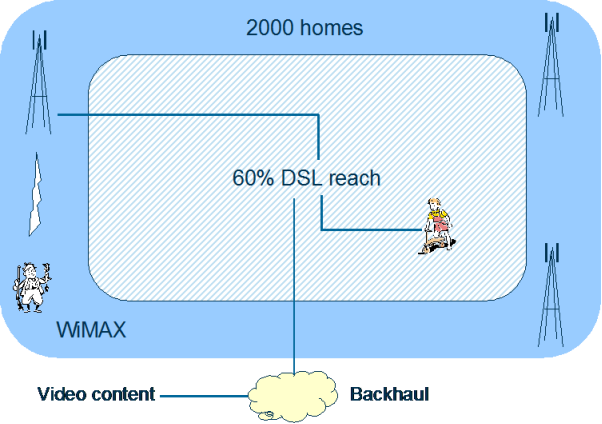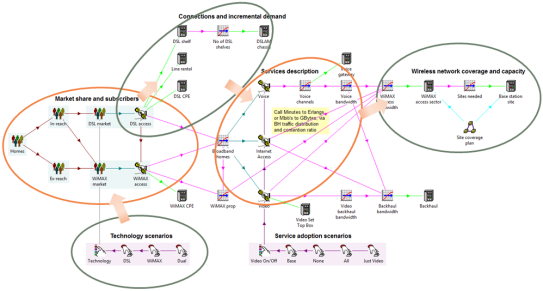Operators are considering broadband fixed wireless access (BBFWA) technologies such as WiMAX as a more cost-effective solution for delivering IP-based services in low-density subscriber areas. In our example, we consider a rural area in which there are 2000 homes, connected over conventional copper to a local exchange. Some homes are a significant distance from the exchange, and only 60% are within reach of the currently available DSL technology. WiMAX is suggested as an alternative broadband solution.

Figure 1: The big picture: WiMAX on the rural (or urban) periphery
The model assumes a network is deployed during 2006, with the launch of commercial service in January 2007. The model generates results for ten years, on a quarterly basis for the first five years, and considers scenarios for each technology in isolation, and also for both running in parallel.
The business envisages WiMAX as a total replacement technology for the outlying homes: for these subscribers, voice and Internet services will both be carried over WiMAX. The model captures the revenue from these separate access platforms (DSL and WiMAX), as well as from the individual services, and performs a high-level dimensioning of the relevant network elements according to the numbers of subscribers and associated traffic levels. The model also considers the addition of an IPTV service, and its impact on service revenues and required network elements.
We start with a very simple network architecture, but we will pile on the complexity later!
- DSL or WiMAX CPE
- DSLAM (and line rental, if this is an alternative operator)
- WiMAX access sectors and base stations
- backhaul – used by both access technologies
- core network – ditto
- set-top box and video server.

Figure 2: Compact model of key telecoms business-model drivers
Wherever you start, this model covers the essentials of business modelling for telecoms networks. The DSL elements are basically dimensioned on ports, whereas the WiMAX network is driven first by the pace of roll-out and coverage, and then progressively by bandwidth as demand increases. Thus, traffic characterisation and service aggregation are central to the end-to-end calculations which link different technology scenarios and penetration assumptions through to network dimensioning, capex forecast, profitability, cashflow and payback on investment.